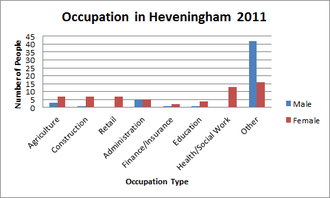Heveningham
| Heveningham | |
 Heveningham, Church of St Margaret |
|
 Heveningham |
|
| Population | 223 (2011) [1] |
|---|---|
| District | Suffolk Coastal |
| Shire county | Suffolk |
| Region | East |
| Country | England |
| Sovereign state | United Kingdom |
| Post town | Halesworth |
| Postcode district | IP19 0E |
| Police | Suffolk |
| Fire | Suffolk |
| Ambulance | East of England |
| EU Parliament | East of England |
Coordinates: 52°18′08″N 1°25′18″E / 52.302129°N 1.421569°E
Heveningham is a village and civil parish in the Suffolk Coastal district of Suffolk in eastern England. Located four miles south-west of Halesworth, in 2005 it had a population of 120. It is where Bruce Reynolds, latterly the brains behind the Great Train Robbery, was evacuated to aged eight, in 1939, during the Second World War.[2]
In 1870-1872, John Marius Wilson's Imperial Gazetteer of England and Wales described Heveningham like this:
HAVENINGHAM, or HEVENINGHAM, a village and parish in Blything district, Suffolk. Haveningham Hall, belongs to Lord Huntingfield. Haveningham Hall was built, in 1777.[3]
Demographics
Population

Around the year of 1800 the population was relatively high in the Parish at approximately 310 people.[4] Since then there was a sharp decrease from 1890 to 1940 when the population fell from approximately 310 to 1900.[5] The decrease in population in the19th century could be due to emigration towards urban centres due to the Industrial Revolution and undoubtedly due to both the First World War and Second World War. Since then, there has been a gradual increase in population, in 2011, including Ubberston 225 people occupied the area.[6]
Age structure
In 2011 there were 52 people between the ages of 0-20.[7] Alongside the approximately 50 people between the ages of 61-100, this created a large proportion of the population who were dependent on the working population. There were around 123 people between the ages of 20-61 considered economically active.[8]
Ethnicity
According to the census, in 2011 Heveningham had a population of 223 people. Out of these, 218 claimed to be of White; English/Welsh/Northern Irish/ British origin, which is 97% of the total population.[9] From the remaining 5 people, 4 people claimed to be White; from outside the UK. 1 person claimed to be of Mixed/Multiple Ethnicity; White/ Black Caribbean.[10]

Occupation
The 1881 census shows that agriculture including cattle rearing was the main source of income in Heveningham. The area was once devoted to pasture with over 60 men stating to work in the sector.[11] Men dominated the working population with 50 women at the time stating they had no specific occupation. Numbera of people working in the domestic sector was high (especially for women) in 1881,[12] this may have been due to Heveningham Hall where servants would have been employed.
.jpg)


From the 2011 census, 58 females claimed to be in employment.[13] 3 Females were employed in the Fishing, Agriculture and Forestry sector. Overall, the majority of women claimed to work for Human Health and Social Work Activities at a count of 13/58.[14] In contrast, 61 males claimed to be in employment in 2011. 7 men worked in the Agriculture, Fishing and forestry sector,[15] whilst 7 men worked in construction, and 6 men worked in Professional/Scientific sector.
Historical landmarks and events
Church of St Margaret
St. Margaret's Church, founded in 1539 is a perpendicular shaped church which is now a grade 1 listed building.[16] The church contains an oak tomb of Sir J. Haveningham.[17]
Heveningham Hall
Built in 1778 for Sir Gerard Vanneck (a Dutch Merchant) by the architect James Wyatt; Heveningham Hall is now protected by the National Trust.[18] After an extensive fire in 1984 the house was renovated and restored in 1994.[18]
Lional Esher has called James Wyatts Hall "the most beautiful room in England.[18]"
County Fair
The summer fair is held annually in the gardens of Heveningham Hall and is a landmark event for the Parish as it highlights the rural traditions that have been maintained throughout time in Heveningham. Activities include a Sheep Show, Clay Pigeon Shooting and a Poultry Exhibition.[19]
References
- ↑ "Civil Parish population 2011". Neighbourhood Statistics. Office for National Statistics. Retrieved 17 September 2015.
- ↑ Reynolds, Bruce (1995). Bruce Reynolds: The Autobiography of a Thief. Bantam Press. p. 5. ISBN 978-0-7535-3917-0.
- ↑ Wilson, John (1870–72). Imperial Gazzetter of England and Wales. Edinburgh: A. Fullterton & Co.
- ↑ "History of Heveningham". A Vision of Britain Through Time. Vision of Britain. Retrieved 22 April 2016.
- ↑ "Population Records 1881". A Vision Of Britain Through Time. University of Portsmouth. 22 April 2016. Retrieved 22 April 2016.
- ↑ "Adult lifestage- population statistics Heveningham". Neighbourhood Statistics. Office for National Statistics. Retrieved 24 April 2016.
- ↑ "Adult lifestage- Population Statistics". Neighbourhood Statistics. Office for National Statistics. Retrieved 24 April 2016.
- ↑ "Adult Lifestafe- Population Statistics". Neighbourhood Statistics. Office for National Statistics. Retrieved 24 April 2016.
- ↑ "Ethnic Group 2011". Neighbourhood Statistics. Office for National Statistics. Retrieved 20 April 2016.
- ↑ "Ethnic Groups 2011". Neighbourhood Statistics. Office for National Statistics. Retrieved 22 April 2016.
- ↑ "1881 Occupational Orders". A Vision Of Britain Through Time. University of Portsmouth. Retrieved 24 April 2016.
- ↑ "1881 Occupational Orders". A Vision of Britain Through Time. University of Portsmouth. Retrieved 24 April 2016.
- ↑ "Industry in Heveningham". Neighbourhood Statistics. Office for National Statistics. Retrieved 24 April 2016.
- ↑ "Industry- Females 2011". Neighbourhood Statistics. Office for National Statistics. 20 March 2016. Retrieved 20 March 2016.
- ↑ "Industry- Males 2011". Neighbourhood Statistics. Office for National Statistics. 20 March 2016. Retrieved 20 March 2016.
- ↑ "Church of St Margaret". British Listed Buildings. Retrieved 19 March 2016.
- ↑ "Info on Church of St. Margaret". Suffolk Churches. Genuki. Retrieved 22 February 2016.
- 1 2 3 "Heveningham Hall". Peerage Genealogy. Retrieved 21 March 2016.
- ↑ "Heveningham Fair". Country Fair Attractions. 21 March 2016. Retrieved 21 March 2016.